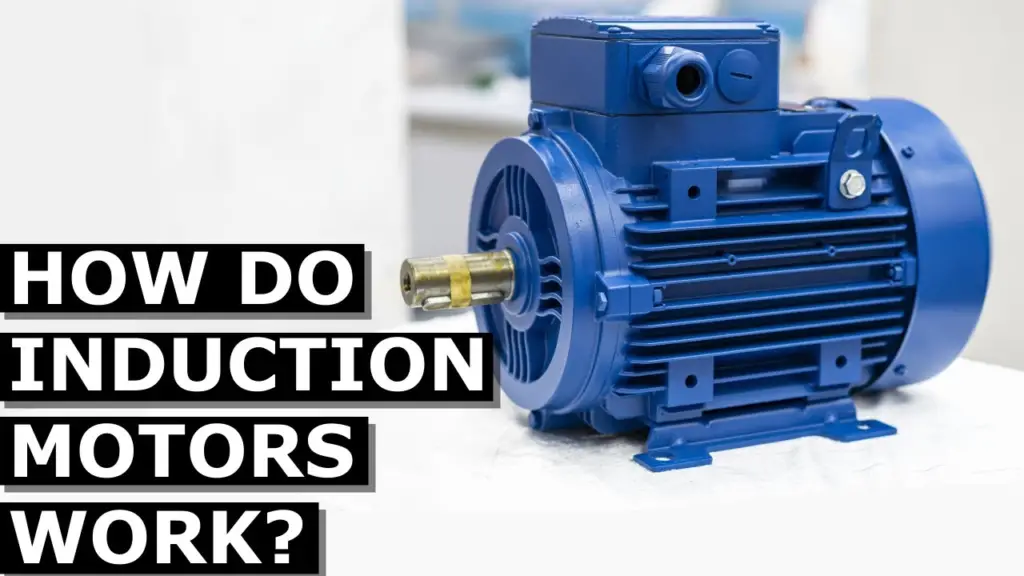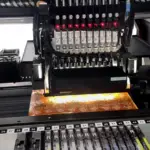Induction motors, often hidden in the background, serve as the unsung heroes powering many of our daily appliances and industrial equipment. Their seamless operation allows for the smooth functioning of everything from your home refrigerator to massive conveyor belts in factories.
As a cornerstone of modern engineering, these motors have revolutionized industries, bringing about unparalleled efficiency and reliability. Their widespread use underscores not just their technical prowess but also their paramount importance in driving the wheels of various industries.
As we delve deeper into this topic, we’ll unveil the workings and significance of induction motors in our interconnected world.

What is an Induction Motor?
An induction motor, commonly referred to as an asynchronous motor, operates based on the principle of electromagnetic induction. In simple terms, it converts electrical energy into mechanical energy, propelling various devices and machinery into motion.
At its core, this motor type primarily consists of two main components: a stator, which remains stationary, and a rotor, which rotates during operation. The magic begins when alternating current (AC) is passed through the stator, producing a rotating magnetic field.
This field, in turn, induces a current in the rotor, causing it to spin. Unlike other motor types such as synchronous motors, induction motors operate slightly below the supply frequency, making them “asynchronous.”
The inherent advantage of induction motors is their self-starting capability, a distinct feature setting them apart from other electric motors. Their robustness, simplicity in design, and absence of commutators make them a preferred choice in a myriad of applications.
Principles Behind the Induction Motor:
Central to the operation of induction motors is the principle of electromagnetic induction, postulated by Michael Faraday. He discovered that a change in the magnetic field within a closed loop of wire induces an electromotive force (EMF) or voltage in the wire. In the context of an induction motor, the stator, equipped with coils, creates this changing magnetic field when powered by alternating current (AC).
As this rotating magnetic field sweeps past the rotor, currents are induced in the rotor due to Faraday’s law of electromagnetic induction. This induced current generates its own magnetic field, which, under the influence of the stator’s magnetic field, results in the rotor’s rotation.
Like Us on Facebook!
The interplay between the stator and rotor is crucial; while the stator generates the primary magnetic field, the rotor reacts to this field, producing motion. This dance of electromagnetic forces brings the motor to life, driving machinery and appliances.
Subscribe Us on YouTube!
Types of Induction Motors:
Induction motors can be primarily classified into two main categories: single-phase and three-phase induction motors.
Single-phase Induction Motors
As the name suggests, these motors operate on a single-phase power supply. Commonly found in household appliances like fans, washing machines, and small pumps, they are ideal for operations that require lower power. Their design is simpler, but they often need auxiliary means to start, given that a single-phase current doesn’t produce a rotating magnetic field by itself.
Also Read: Keeping Automation in Mind When Choosing a Five-Axis Machine Tool
Three-phase Induction Motors
Utilizing a three-phase power supply, these motors are the stalwarts of industries. They produce a naturally rotating magnetic field, making them self-starting. Known for their higher efficiency, robustness, and consistent power delivery, they dominate industrial machinery, large pumps, and compressors.
In essence, while single-phase motors are tailored for lighter, residential tasks, three-phase motors are geared towards heavier, industrial applications, offering a perfect blend of power and reliability.
Advantages of Induction Motors:
Induction motors, over the years, have become the motor of choice in many applications, and the reasons are manifold:
Durability and Robustness: One of the standout features of induction motors is their rugged construction. With fewer wear-prone parts and no brushes or commutators to degrade over time, these motors boast longer lifespans and can withstand challenging operational conditions, making them ideal for rigorous industrial applications.
Efficiency and Performance: Induction motors, especially the three-phase variants, deliver a consistent and smooth performance. Their ability to maintain a steady speed under varying loads is commendable. Moreover, technological advancements have further enhanced their efficiency, ensuring optimal energy utilization.
Cost-effectiveness: In the long run, induction motors prove to be economical. Their initial purchase cost is competitive, and when you factor in their longevity and reduced maintenance needs, they offer substantial savings.
Common Applications of Induction Motors:
Induction motors have seamlessly woven their way into various facets of our lives, powering a multitude of devices and systems. Here’s a snapshot of their ubiquitous presence:
Household Appliances: Within our homes, induction motors are the silent force behind numerous gadgets. From the cooling breeze of ceiling fans to the tumbling of washing machines and the cold embrace of refrigerators, these motors ensure our domestic comfort and convenience.
Industrial Machines: On a grander scale, industries heavily rely on induction motors. They drive conveyor belts, power large-scale fans, operate pumps, and fuel the machinery that crafts products we use daily. Their resilience and efficiency make them indispensable in manufacturing, processing, and production environments.
Transportation: Though not as commonly acknowledged, induction motors play pivotal roles in transportation, especially in electric trains and certain electric vehicles, converting electrical energy to motion, pushing the boundaries of speed and efficiency.
Maintenance and Troubleshooting:
For all their resilience and efficiency, induction motors, like any machinery, require periodic attention to function optimally.
Common Issues Faced: Overheating, unusual noises, and reduced operational efficiency are typical signs of an induction motor in distress. Factors like imbalanced voltages, bearing failures, or incorrect alignments can lead to these issues.
Tips for Proper Maintenance:
- Regular Inspection: Keep an eye on motor components, checking for wear and tear.
- Cleanliness: Ensure the motor is free from dust and debris, which can hinder cooling.
- Lubrication: Periodically lubricate the bearings to minimize friction.
- Check Connections: Tighten any loose connections to prevent voltage imbalances.
- Monitor Temperature: Avoid operating the motor beyond its thermal limit.
- Vibration Analysis: Use it as a preventive measure to detect misalignments or bearing problems.
When to Seek Professional Help: If issues persist despite regular maintenance, or if the motor displays symptoms like erratic speed variations or frequent tripping, it’s prudent to consult a professional. They’ll have the expertise and tools to diagnose and rectify deeper-rooted problems, ensuring the longevity and efficiency of your induction motor.
FAQs on Induction Motors:
What is the main principle of an induction motor?
The induction motor operates on the principle of electromagnetic induction. When a magnetic field changes around a conductor, it induces a voltage in the conductor. In the motor, the stator creates a rotating magnetic field, inducing a current in the rotor, which in turn produces its own magnetic field that interacts with the original, causing rotation.
How does an induction motor start?
Three-phase induction motors are naturally self-starting. The rotating magnetic field produced by the stator induces a current in the rotor, initiating motion. Single-phase motors often require additional starting mechanisms since a single-phase current doesn’t naturally produce a rotating field.
Are induction motors AC or DC?
Induction motors are fundamentally AC motors. They operate using alternating current to produce a rotating magnetic field in the stator.
How is the speed of an induction motor controlled?
The speed can be controlled using methods like varying the supply frequency with a variable frequency drive (VFD) or adjusting the number of poles in the motor.
What is the efficiency of an induction motor?
Efficiency varies based on the design and load. Under optimal conditions, modern induction motors can achieve efficiencies above 90%. However, this figure can fluctuate based on the motor’s size, design, and operating conditions. Always refer to the manufacturer’s specifications for precise efficiency ratings.
Conclusion
Induction motors, with their impeccable blend of efficiency, durability, and versatility, stand as the backbone of numerous appliances and industrial setups. Their silent yet impactful presence in our daily lives underscores their indispensable value. As we’ve navigated their workings and applications, it’s evident that there’s a vast expanse of knowledge to unearth about these engineering marvels. I encourage enthusiasts and curious minds to delve deeper, for understanding induction motors is a journey into the very heart of modern machinery and innovation.
Get high-quality induction motor lamination stacks from Lammotor in China!
Elevate the performance of your induction motors with the best in class! At Lammotor, we specialize in providing top-tier induction motor lamination stacks, ensuring optimal efficiency and longevity for your machinery. Don’t compromise on quality when the heart of your motor is at stake. Dive into the realm of unparalleled performance and reliability.
Choose Lammotor’s lamination stacks, crafted with precision and designed to exceed expectations. It’s time to power your motors with the best. So why wait? Embrace excellence and make the switch to Lammotor today!





















